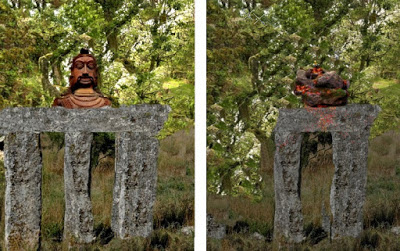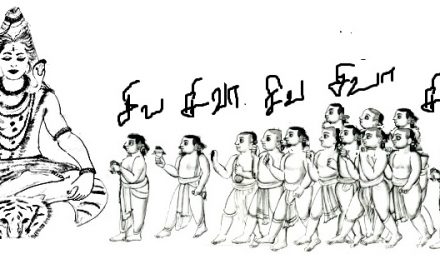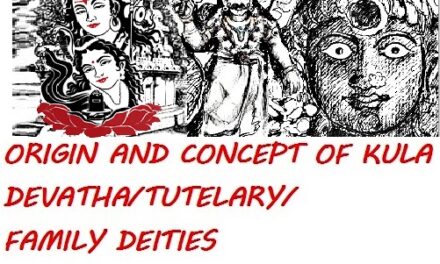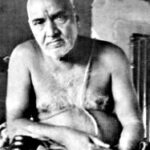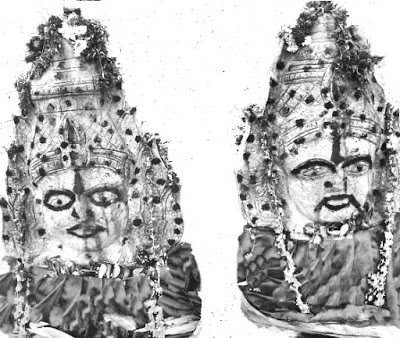

In the past, people always believed that quite often numerous good and evil Spirits dwelled or visited their villages for some reasons, few attributed to the visit of Spirits and Souls are :
- that they may have belonged to those places they visited
- met both natural or unnatural death while dwelling there and
- some their family members dear or inimical to them stayed there
- some of the Souls of those who met with premature death due to deceit of some members visited there to take revenge on those responsible for their (soul) unnatural and immature death.
- reading several Puranas, one is inclined to believe that the Souls of the ancestors who demised turn into wandering Souls till they get rebirth and such Souls visit the places where their families dwelled in order to not only protect them but also to satiate their hunger till they (souls) get rebirth.
Beyond above, the general feeling of the villagers have always been that the pious Souls stayed in their villages as Guardian Deity to protect the community who worshiped them and shield the village from attacks of not only evil Souls and Spirits, but also protect the villages from natural calamities like flood, breaches in rivers, storm etc. The community feared that if such pious Souls are disrespected they may in act of vengeance and spread dreadful diseases and disasters culminating to misery and will remain mute spectator against natural disasters. The community therefore treated the unknown souls as Guardian angels (Souls), Village Deity or Village God and worshiped them. The evil Souls which wander as Ghosts for the sins committed, if attempt to enter the villages, they will be driven off by the Guardian Deity of the villages, the community believed. This formed the basic reason for establishing and worshiping Village Deity or Village God in the Villages.
In respect of the sinner or evil Ghosts, the belief stemmed from the sermons in many of the Puranas that state so and so will happen against so and so sins and advised redemption exercises like sacrifices to be done in many forms or penance to please certain Deities to undo such sins. As per Vedic rules, the sinners are born as Rakshasas, Asuras, Evil souls or Ghosts according to the intensity of the crime committed or the doom they received and thus during the said transition period, while the Rakshasas and Asuras turn into Ghosts and wander in jungles, the Souls wander in space in thirst and hunger. Such wandering Souls move over to some Villages and stay there threatening people. Such stories propagated systematically through word of mouth stories for generations infused fear in the minds of people and fear thus generated led to the installation of Village Deities by erection of statues to the unknown Souls called Angels, sinner Souls and Deities in some form or the other and to offer oblation to them with respect to appease and tone down the fury of such to Souls to safeguard themselves from the attack of unnatural. Therefore they resorted to the practice of :
- worship of Souls in the form of village Deities or Ghosts
- convert and worship specific spots in their dwellings where the departed souls have rested on mile stones, grain heaps, tree shades etc
- annual or regular worship at fixed intervals to the Souls and Village Deities
Thus the communities in the Villages installed terracotta statues of various figures resembling male or female or even animal Deities with the hope that the savior Souls of the village will reside inside the statues thus installed and the Statues can be worshiped to get protection from them. While in community level, the Village Gods or Village Deities were installed and worshiped, on personal level many villagers believed that some of their demised family members may be wandering as Souls and they need to be respected to get their blessings which will bring happiness and prosperity to the family. Therefore they began worshiping them in the form of a Stone or some Geometrical designed art painted on walls inside their houses, lighted up a oil lamp in front of the image, decorated them with flowers and worshiped them regularly. The fear of displeasing the Souls of the dead ancestors would haunt them with incurable diseases and malady they feared and resorted to this practice. Therefore appeasing the ancestral Spirits in some form became part of their life inside homes.
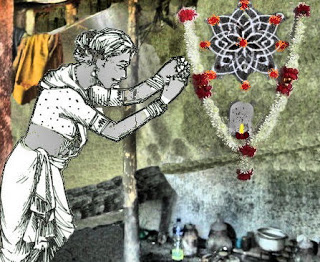
Besides above, the steps to the entrances of their houses used to be spread and dried with Cow dung, certain symbols like Swastika, Lines with a Dot in center are drawn on entrance doors or walls, Vermillion and Turmeric paste applied on the steps and walls etc. The belief was that the Evil souls will not dare to enter the houses crossing the divine Cow dung or the divinely symbols for fear of the mystic powers of several of the male and female Deities residing in Cow dung, Vermilion and Turmeric powders and in the designs drawn as they were in a way considered Yanthra of Deities guarding the houses. For example the two circles with center dot represent the third eye of Lord Siva. The Swastika and circles with dot inside is power of the female Deity. These were general beliefs spread among the public in Villages.
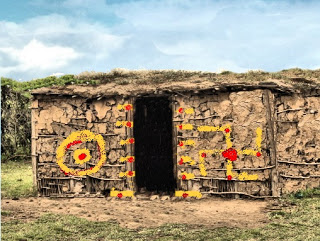
With the above background in mind, the Village community installed huge terracotta statues in the entrances at the dwellings, Village entry points etc treating them as Village Deity or Guardian God. In some of the village entrances one can see big statues of male or female figures some of them carrying Swords, Sickle and Sparrow or child in hand etc. People believed that they would guard the villages like Kadamban (an Asura turned to lord’s servant) who stood as guard to Lord Muruga, and Muneeswaran (name of a male attendant) who stood as guard to Amman (Female deity emanated from Parvathi, Lord Siva’s spouse). It is widely believed that the Village Deities, at the entrance of the villages or in remote places of the Village ensured that no Evils dare to enter into the village and if and when they attempted to enter they were driven back by the Deities, God or Souls entrenched there as Village Guard.
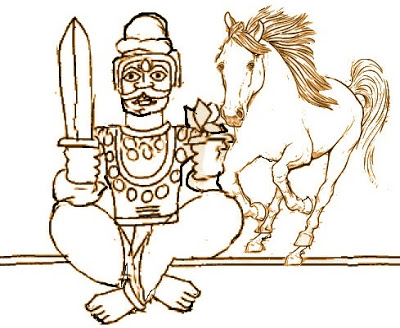
As one visit several interior Villages, one can find at the Village entrance huge statues of terracotta figures, with or without horse or some animals standing by their side, all painted in variety of colors. Some of the Deities represented ichnographically are in threatening posture carrying weapons (club, sword, cleaver, and whip) in both hands quite often with a big horse or animal standing by their side. Horse by nature has sensory power on the wandering Spirits and Ghosts and therefore the Village Deities have with them Horses as carrier to reach the dwellings of Spirits and Ghosts to destroy them. Thus goes the belief. Who used to be regarded as Village God or Deity besides Puranic Gods seated in the temples? No matter male or female, those who become Village Deities for one reason or the other were:
- souls of some one who died in the Village
- those fought for the Villagers cause
- those stood against tyranny and died subsequently
- killed in war or while saving their community members or
- those done to death in acts of deceit
The story behind some of the Village Deities are that they have turned into wandering souls after being killed in act of deceit and in retaliation the Souls attempt to disturb harmony and peace, wrecking damages in several forms by bringing storms, breaches in the river, contaminate water etc to the village where they were slain. Therefore in an act of atonement or to appease them their statues were installed as Village God or Deity and worshiped. Most of them had some interesting story behind them before being accepted as Village Deity. It is also interesting to note that the life and stories of those dead both male and female and configured into the terracotta statues and that of the Souls and Spirits worshiped as Village Deity or Village Gods are many.
Usually the Village Deities in all the Villages are not configured with some image, but some may be even simple stones without any image scribes or chiseled and kept on raised platforms or stone pillars either as formless structure or with some images too. They are also generally located at the outskirts of the villages. At some places the images of the Deities painted on the pillar can also be seen.
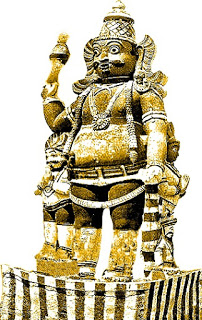
There is also perception that some of the souls are none but Bhootha Ganas (angels) sent by God themselves as their agent angels, in difference to the prayers of the people to protect them and to guard their villages. Those Spirits and the Guardian Angels had fixed spheres of life and influence. The villagers attempt to live in harmony with those Spirits and offer them periodic oblation which the Angels would accept and in turn, the villagers believe, the Spirits and Souls guard them in all aspects in life including their dwellings and fore warn them on impending dangers and calamities to their Villages. There is another interesting aspect involved in Village Deities. The Villages attempt to talk to the Village Gods through some medium during the annual or periodical festivals conducted to please the Village Deities or Souls. This differs from place to place.
The Pujas performed for the Village Deities are quite different from Agama way of worship and the one performed in the regular temples. During the festival, as the community bhajan and other mass prayers are held, one can see strange scenes happening. Supposedly possessed by Spirits and Souls, some one from the crowd suddenly go into trance, talk loudly or laugh noisily and dance in ecstasy claiming themselves to be so and so Deity or Soul. The patiently waiting public remain silent to hear what the Soul or Spirit say through the person in trance. Dancing in ecstasy, the Soul influenced person in trance give the villagers guidance, expose the misdeeds of individuals, warn about the impending dangers etc, etc like water flowing from the tap. The people on spot respect those who go into trance as they were able to expose even the hidden secrets of the persons some of whom they may not have even met before or known nor talked to. Therefore the belief of the Villagers gain strength to accept the theory that the person in trance has gained super natural power at that point of period, and unless the fact is so how could those in trances derive such energy and spell out the vast information of those whom they have never met before.
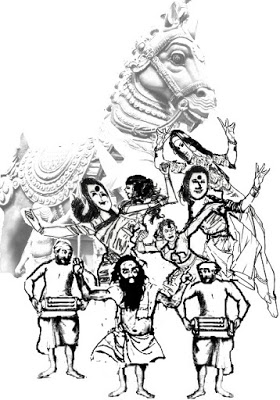
The dance in trance continues for few hours at one stretch loudly calling names, acts, impending peril etc without showing any signs of tiredness or weakness and the trance influenced person gets back to their original form after performing the act and fall tired. Such incidents are quite common in the village festivals in the midst of ear puncturing loud beating of drums and other instruments which slowly gets intensifies to generate sense of fear in the minds of those assembled. The night long ceremonies conducted in a well-organized manner with all pomp and festivity in a well decorated arena gives the appearance of a ritualistic stage. While the image of the deity and other objects of worship continue on one side, the disciplined devotees sit on the other side watching the trance dances.
In parts of three states like Karnataka, Tamilnadu, Madhya Pradesh, rituals to the worship of the village Deities, Souls and Spirits are performed in awesome spectacle and strange fashion to safeguard the families and self. However most of the festivals end up with animal sacrifices and blood sucking by the ritual performing pundit who again is one from their village community. Hundreds of animals used to be sacrificed by cutting their heads and pouring the blood from the severed heads on to a fixed place or in pots kept for the purpose which used to be mixed with rice or food and served as Prasad of the deity.
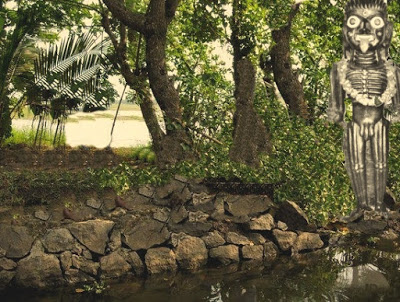
In the state of Karnataka, a tribal sect called Gange matha, cover their faces with special masks, carry large bunch of neem leaves and dance to please the village deities like Rakthakateswari and Mariamma (not Mari Amman). The make-up of the dancers differs according to the sex of the spirit. The ritual dance is very artistic. Different colors of masks to symbolically display the characteristic features of the good and bad Spirits are used. Sometimes the ritual begins by performing animal sacrifices and offering blood to appease the Bhoothas called the deity. The performer will then dance to a special music which will be spine chilling. Such practices are more prevalent in the region of Thulu, which is predominantly tribal based. Since the place is near Kerala Coast, their art resembles with the Keralian art and folk dance Yakshagana. Kerala appears to have more tantric rituals. In the city of Mangalore too the performance of Bhootha Aradhane (worship of bhootha ganas) is prevalent. Generally such festivals are held in Jan- Dec every year.
In the 9th century, in the states of Orissa and Madhya Pradesh, the interior parts of many areas being tribal, the worship of Mohinis and Yoginis, known for mysticism were highly prevalent. Others believed that the Spirits, Ghosts, or Demons are guardian deities for Goddess Parvathi. The Mohinis reflected sixty four moods of life. Some of the faces of the Mohinis were like that of the animals. The temples built in the 9th and 10th centuries for Mohinis stand testimony to the art. Even now the tantrics visit the temple in belief that the Mohinis and Yogins stroll in the skies above the temple during mid night in invisible form and if they are appeased they grant them mystic and tantric powers to perform certain rituals. A majority however believe that Mohinis and the Yogins were Angels and Spirits sent to protect their villages and they are worshiped as Village Deities or Village Gods .Such belief exists in some interior parts of Tamil Nadu, Sri Lanka and Andhra too.
In Tamil Nadu, the village Deities like Aiyyanar, Kuthirai Veeran, Karuppaswamy, Kateri Amman, Pachaiyamman, Ellaiamman, Agni Veera Badrar, Karuppayee Amman, Sangili Karuppu, Meyyandi Amman, Nagappasamy, Sannasi, Pechiamman, Sappani, Sonai, Lada Sannasi, Chappani Karuppan , Sangili Karuppan. Chinna karuppan, Idumban, Veerabadhran, Bairavan and Sudalai Madan are worshiped in different as Guardian Deities. Based on the caste and tradition to which one belonged, the Deity in the villages has assumed such names.
In the north Indian States, the concept of Village Deities are mostly unknown except in parts of Bihar, Madhya Pradesh and Orissa where the tribal are concentrated who worship some form of Village Deities. Otherwise in general, Lord Shiva’s Ganas and Snakes, Mohinis, Yogins, Kali, and Lord Bhairava are kept in the village entrances or in the first reachable temples to stand guard to their villages. Some of the statues used to be in half body, some have only the face of some Deity or simple Stone that were worshiped. They believe that the said Deities stand guard to their area. Apart from it they also believe that Lord Anjaneya is the Guardian Deity. May be this belief has been the reason to find temple with Anjaneya installed in the form of a simple stone painted in orange colour. The temple used to be the place where Anjaneya resides to guard the Village from attacks of evils.
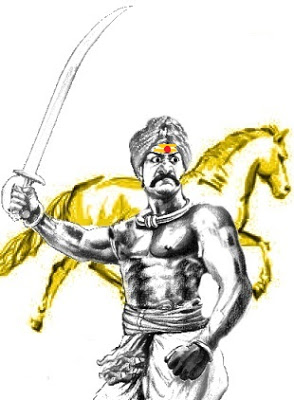
In a very interesting lecture series one of the speakers spoke thus on the worship of Village deities, spirits and Bhootha Ganas:
The general belief is that a soul released from the dead, wander in different places till they get rebirth. The souls called as spirits and ghosts wander mostly in the isolated areas and stay over the tamarind trees (reason or the preference for the tamarind tree by the ghost is not known), many of which are found at the entrances to the villages. They temporarily occupy the senses of some one who pass through the area and the spirit possessed person behaves erratically expressing the features of the spirits. When such instances increased due to many reasons borne out of fear, the villagers began to treat such places as that of the guardian deities, erected their statues based on those narrated by the possessed persons and offered periodic oblation with the belief that in turn they may protect the villages. In fact neither puranas nor archeological evidences suggest the origin of the village deities. Every bit of stories that we hear on the Ghosts, spirits and Village deities are from the folk tales orally carried over by generations. The village deities in the form of a huge, fierce statue or as a simple stone mostly represented the images some one or the other saw in their dreams.
In the early periods of civilization, whenever the natural disasters like famine, drought, and epidemics occurred, it was quite common that some one or the others in the villages had helped the people in one way, stood for justice, valiantly fought for justice, or lost their life for the cause of justice. They may have become heroes. Later the people considered all the places visited by those heroes, the culverts on which they had rested etc to be sacred places and started worshiping them at those places. In the festivals held in the villages, the heroic acts dominated the folk songs sung tales told there. The villagers sang the ballad that narrated the birth of that hero, his descent into the land, heroic deeds, his travels and sphere of influence etc. The narrated the events saying ‘so and so rode the horse thus’, ‘swung the sword thus’ and ‘jumped to drive away and kill the enemy thus’ etc by appropriate gestures. In olden days, when people traveled from one village to another, and those who relaxed near those culverts prayed to the culverts of heroes for safe journey. As the time passed those heroes became semi god and slowly these milestones attained the position of village gods and goddesses.
One of the reasons for the emergence of semi gods was also due to the restrictions imposed to the non Brahmins in entering the temples. The divisions in the society like lower and out-caste started surfacing. Only Brahmins performed rituals and certain non Brahmin upper caste allowed entry into the temples. The acts of invoking evil spirits to disturb the families in the form of invoking black magic were prevalent on large scale to scare the lower caste and untouchables and outbreaks of epidemics attributed to the entry of out-caste in certain areas in the villages. All such acts left deep resentment into the minds of people, which slowly pushed them to seek alternative places worship. Thus the village heroes became to be viewed semi gods, else where will the oppressed go and vent their feelings? Slowly the village deities like Kathavarayan, Sooli, Rakthakateri, Mariamma, Peyandi, Kuthirai veeran etc to replace the temple devis surfaced. Their statues in the form of clay dolls, terracotta, and plain stones with some kinds of engraved images were erected and worshiped.
Why most of the Village deities were that of female gender is another interesting point to note. It may be because that a female can only conceive and deliver babies and likewise the seeds, which produced food grains, were viewed as female. Since female feel shy to deliver baby before male, the land where the process of food grain production took place was similar to delivering a child and bringing them up and needed to be guarded by a female. Therefore the deities that guarded the fields’ were female in gender. Then how did the deities guarding the lands became Bhoothas? Simple! The clay dolls, mud idols, or the one made with bamboos gave awesome and fearsome look to drive away the birds and animals, and hence called Bhoothas.
As per a orally carried folk tale through generations, there lived a local hero called Madurai Veeran, in the seventeenth century. He was very compassionate and helpful to people and a solder in the army of the King. The King who doubted his integrity on account of false news killed him. Though a King killed him in deceptive manner, his soul continued to wander in his home town, sitting on a horse and protected the village. Madurai Veeran drove away the evils that tried to enter the village. Therefore people believed that worshiping him will help the villages remain free from evils and Madurai veeran came to be accepted by the villagers in general as the Village God or Deity “

